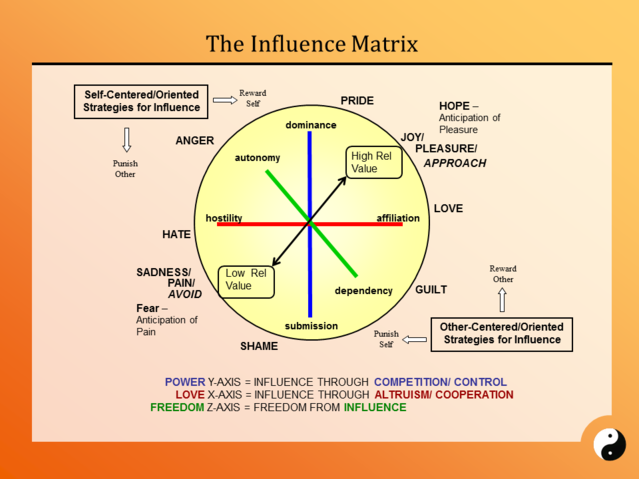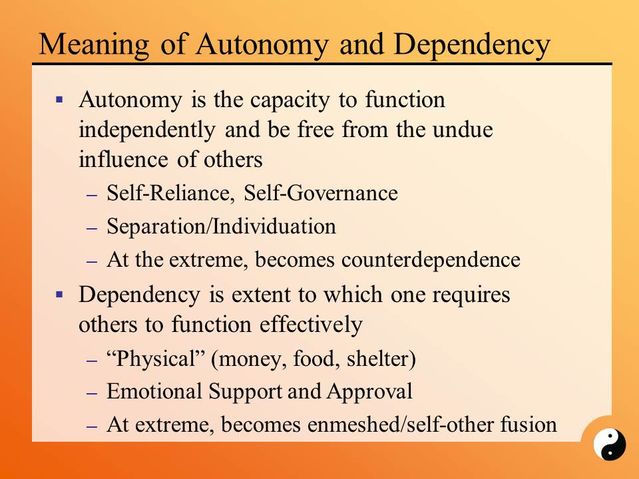Attachment
Dependency, Counter-Dependency, and Interdependency
Understanding the green line on the Matrix.
Posted December 17, 2016
“Maybe I should just tell them to go to hell,” Sharon was saying to me, clearly upset and angry. She had gotten in a major fight with her friend group and at this moment was feeling strongly the urge to distance herself from them. “I don’t need them, they just give me grief." Ten minutes later, Sharon was in a different place. Fearing the isolation that would follow leaving her friend group, she said tearfully, “It will be awful. I won’t have anyone to do stuff with or share what is going on.”
Sharon was experiencing a “Dependent/Counter Dependent” split in her relational system. Such a conflict is not uncommon, and here I help readers get a clearer handle on the drives and emotions underlying this dynamic.The picture I use to map the human relationship system is called the Influence Matrix. According to the Matrix, humans have a system of adaptation that is automatically framing, tracking, and reacting to changes in one’s relational field on a number of key dimensions.
The first and most important dimension that is tracked is represented by the black line and it is called the Relational Value-Social Influence line. The Matrix posits that all humans have the need for Relational Value, which is the need to be known and valued by important others in one’s life. Positive changes in being valued generally elicit positive emotions, and the reverse is also true.

In addition to the black line, there are three other relational process dimensions on the Matrix. The blue line tracks competitive rank and status-type interactions (i.e., who has more control, power, more ability, or status in a domain). The red line tracks cooperative and affiliative processes (i.e., the extent to which we are attached to and share in other’s interests).
The blog is about the green line, which in some ways is the most complicated. The green line tracks your involvement with others. It ranges from extreme dependency on the one hand (a state where someone is completely emotionally dependent on the attitudes and approvals of others—this is exemplified in Dependent Personality Disorder) to extreme independence on the other (which is where an individual denies any needs for connection, attachment or approval—this is exemplified in Schizoid Personality disorder).

Let’s discuss the green line from the position of development. At birth, human infants are completely dependent on the investment from others for their protection and survival. Of course, much of the variance on whether or not such investment occurs resides in the desires and abilities of the primary caretakers. Nonetheless, as any parent who has heard an infant cry in distress or cooed in satisfaction can attest, human infants have powerful capacities to influence caretakers and elicit investment. Care eliciting behaviors can be conceptualized as expressions of the infant’s dependency needs. Broadly speaking, there are two related but separable kinds of dependency needs, physiological and socio-emotional. Physiological needs refer to basic survival needs and include protection from harm, food, temperature regulation, and so forth. Socio-emotional needs refer to relational needs and include cuddling, eye contact, and the expression of positive emotion by the caretakers in the service of fostering a sense of emotional security. We can turn to John Bowlby’s attachment theory and the way it was extended by Mary Ainsworth to get additional insight into how differences in relational systems might develop.
Mary Ainsworth introduced the concept of the caretaker being a "secure base" from which to operate and explore the world. Ainsworth proceeded to identify three different attachment styles; secure, insecure ambivalent, and insecure avoidant. These attachment styles, examined from the vantage point of the Influence Matrix, can clearly be understood as representing different socio-emotional strategies for influence. Securely attached children have their basic needs for relational value and social influence met and, consequently, feel more positive, safe, and comforted by the presence of the caretaker. In contrast, insecure children are theorized to not have their dependency needs met at least in some ways, which results in a general registering of low relational value, and this is associated with negative emotions, most notably fear.
The two insecure attachment styles represent two different influence strategies on the green line, autonomy-dependency axis. Namely, ambivalent children adopt a hyper-dependent strategy, characterized by strong emotional displays of need and fear of not receiving the necessary parental investment. In contrast, avoidant children adopt a hyper-autonomous strategy that can be understood as minimizing dependency needs and care-eliciting displays.
Although dependency is an inevitable starting condition, it nevertheless is, by definition, a rather vulnerable state. If the interests or capacities of the individual on whom one is dependent changes away from the individual, then difficulties inevitably follow. In addition, achieving social influence via competition and altruism are endeavors that take time and energy that could potentially be spent doing other things. These opportunity costs occur in the best of cases. In worst case scenarios, social exchanges can result in individuals either being dominated and controlled or sacrificing without receiving any beneficial return. As a consequence of all of these dynamics, individuals are theorized to be motivated toward self-reliance and the avoidance of excessive dependency on others (see here for more on counter dependency).
Autonomy, which is defined as the capacity to function independently and be free from the undue influence of others, has been emphasized as a key psychological motive or need by a number of clinical theorists and researchers. For example, Carl Jung emphasized the importance of individuation, and the separation-individuation dynamic remains central to many psychodynamic theories. Similarly, autonomy versus shame and doubt is the second developmental task in Erikson’s model of ego development. Carl Rogers argued the fully functioning person had an internal locus of evaluation, and Marie Jahoda argued that self-direction and the freedom from the control of others were central to mental health. More recent psychological researchers, like Carol Ryff, have argued strongly that a sense of autonomy is crucial to psychological well-being.
Of course with too much independence, the opportunities for one’s social needs to be met are greatly diminished. Indeed, extreme independence is likely to be a function of counter-dependence, meaning that the individual separates from others out of fear of failure, betrayal, rejection, or other costly social encounters. There is, thus an important difference between healthy individuation and counter-dependence. The former is an “approach mindset” where an individual takes pride in discovering themselves and their capacities as unique individuals, whereas the latter is an “avoidance mindset”, where the focus is on dangers to be protected against. According to the Influence Matrix, a balance between independence and dependency, what might be called a state of healthy autonomous-interdependence, is expected to be associated with optimal relational functioning.

How can this map help Sharon? First, it can help her understand herself and what her feelings are telling her. Without a map, she might be really confused as to why at one moment she is proclaiming that her friends can go to hell and that she does not need them and then 10 minutes later she is flooded with fears of being alone. What is happening to her is that her mind is cycling through the different poles on the green line. The separation/counter-dependent pole is attempting to protect her from betrayal and is attempting to minimize the power others have over her. The dependency pole is acknowledging her need for relational value, social influence and involvement, and human companionship.
She can also recognize that although both poles are helpful, the most adaptive place is usually found in the sweet spot between them. The task of her self-consciousness system is to take the strong feelings from both of the poles and find a way to integrate them. How could she do this? First, she can notice that she is “splitting” a bit, that is, that she is feeling all one way and then all another. That is natural, but the next task is to be able to hold the two feeling poles at the same time. For example, it is the case that she will survive without her friends and she clearly has some normal healthy dependent feelings and thus to lose them will hurt. And, although it will hurt, it also is the case that she has capacities to function independently if absolutely necessary and will then have more opportunities to form different relationships. And it was the case that she was involved in these relations for good historical reasons, so it is very important that she thinks through the conflict and makes sure she is making the best overall decision.
In sum, the green line on the Matrix maps a key socio-emotional process, which ranges from extreme counter-dependency on one end to extreme dependency on the other. Both extremes are problematic for adults, and the most adaptive place is in the sweet spot between these poles, a healthy autonomous interdependent state.




